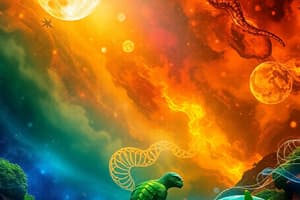Podcast
Questions and Answers
What is natural variation?
What is natural variation?
- A method of genetic modification.
- A process that helps individuals survive and reproduce. (correct)
- A type of mutation.
- A theory of evolution.
What leads to phenotype variation?
What leads to phenotype variation?
Genetic variation
What are adaptations?
What are adaptations?
Traits or behaviors that have evolved through natural selection.
What is a mutation?
What is a mutation?
What does evolution refer to?
What does evolution refer to?
What is a species?
What is a species?
What is a fossil?
What is a fossil?
What characteristics do all mammals share?
What characteristics do all mammals share?
Relative dating gives us an exact age.
Relative dating gives us an exact age.
Absolute dating provides the actual number of years.
Absolute dating provides the actual number of years.
A fossil is the same age as the rock it is found in.
A fossil is the same age as the rock it is found in.
What is antibiotic resistance?
What is antibiotic resistance?
What do similarities in early development indicate?
What do similarities in early development indicate?
What does DNA represent?
What does DNA represent?
Study Notes
Natural Variation and Evolution
- Natural variation is the process by which individuals with traits better suited to the environment survive and reproduce.
- Organisms that adapt effectively pass on favorable traits to their offspring, enhancing survival rates.
- Genetic variation (GV) leads to differences in physical traits (phenotypes) among organisms and arises mainly from mutations.
- Adaptations are traits or behaviors that have evolved through natural selection to improve survival in specific environments.
Mutation and Its Role
- A mutation is a change in an organism's DNA, potentially resulting in new traits. While most mutations can be harmful, some are beneficial and contribute to evolution.
- Most natural variations are genetically determined, forming the basis for evolutionary processes.
Evolution and Life Origins
- Evolution involves gradual changes in species over time, influenced by natural variations and adaptations.
- The origin of life is theorized to begin from a primordial soup composed of organic compounds.
Charles Darwin and Species Definition
- Charles Darwin proposed theories concerning common ancestry among species, emphasizing the role of natural selection.
- A species is defined as a group of similar organisms that can interbreed and produce fertile offspring.
Fossils and Their Significance
- Fossils are preserved remnants or traces of ancient organisms and provide evidence of past life, showing gradual complexity from sponges to mammals over 3 billion years.
- Fossils found in rocks share the same age as the rock layer, assisting in the dating of geological periods.
Structural and Developmental Similarities
- Homologous structures indicate organisms share a relatively recent common ancestor, reflected in similar bone arrangements among vertebrates.
- Vestigial structures are reduced or non-functional parts that no longer serve their original purpose, illustrating evolutionary changes.
- Analogous structures indicate features that serve similar functions but arise independently, not from common ancestry.
- All vertebrates show initial similarities during early development, such as gill slits and tails.
Resistance and Genetic Material
- Antibiotic resistance in bacteria and viruses arises as they evolve and adapt, making them more difficult to eliminate with existing medications.
- DNA contains the genetic information passed from parents to offspring, allowing for the assessment of how closely related different species are, such as the 98% genetic similarity between humans and chimpanzees.
Dating Fossils
- Relative dating compares the age of fossils and rock layers without providing exact age, whereas absolute dating offers actual numerical ages.
- Understanding evolutionary processes through fossil records and genetic analysis continues to shed light on the history of life on Earth.
Studying That Suits You
Use AI to generate personalized quizzes and flashcards to suit your learning preferences.
Description
Explore key concepts of natural variation, genetic variation, and how organisms adapt through evolutionary processes. This flashcard quiz will help reinforce your understanding of the mechanisms that drive evolution and the survival of species. Ideal for students studying biology.




